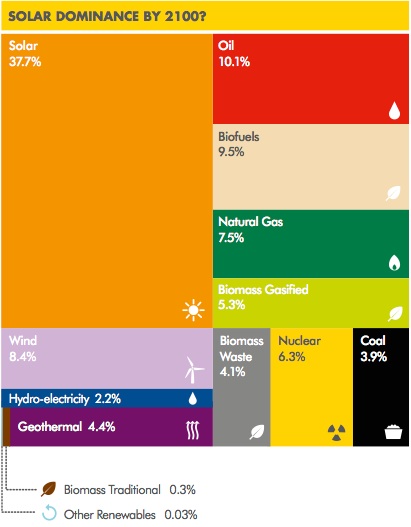Shell’s Oceans scenario projects that solar is the dominant energy source by mid-2060s
 Last week Royal Dutch Shell released its New Lens Scenarios, in which it makes projections about the future of energy use across the world—looking as far ahead as 2100. The Dutch oil giant, whose subsidiary Showa Shell Sekiyu owns Solar Frontier, projects that under one of two scenarios, the Oceans scenario, that solar could be the world’s dominant energy supply by as soon as the mid-2060s, and by 2100 provide 37.7 percent of all the world’s energy.
Last week Royal Dutch Shell released its New Lens Scenarios, in which it makes projections about the future of energy use across the world—looking as far ahead as 2100. The Dutch oil giant, whose subsidiary Showa Shell Sekiyu owns Solar Frontier, projects that under one of two scenarios, the Oceans scenario, that solar could be the world’s dominant energy supply by as soon as the mid-2060s, and by 2100 provide 37.7 percent of all the world’s energy.
However, that’s just one of two scenarios that calls for solar to make up that much of the world’s energy supply in coming decades. The other scenario, the Mountains Scenario, accounts for significantly less solar and renewables.
The company explains why it developed the two viewpoints: “The world in the future will be defined by how people and governments meet the challenges posed by institutions, inequality, and insecurity in relation to the paradoxes of prosperity, leadership, and connectivity.” This includes projections of economic growth in India and Africa, which could greatly influence how energy is used in the future.
The Mountains scenario looks at a world “where the benefits of an elevated position are exercised and protected, and those who are currently influential hold on to power.” Under that scenario, solar and renewable energy will continue to grow, but at a slower pace and fossil fuel sources will continue to dominate energy production, thanks to maintaining status quo policies throughout the world and sluggish economic growth.
The Oceans scenario looks at a world “with rising tides, strong currents, and a volatile churn of actors and events with an irregular accommodation of competing interests.” Under the Oceans scenario, “The rise in solar is due, in part, to public pressure governments to prioritize it in the electricity ‘merit order’,” Shell said. The use of significant additional solar would be accommodated by ramping up other forms of electric generation during cloudy periods, including hydroelectric—where available, and otherwise, gas, coal, and biomass. This could force regulators to pass grid-balancing costs to consumers, it projects. While that could be seen as a bad thing, it could spur more innovation. “This encourages end-users to develop local solutions to even out their daily energy supply and demand.” It could include energy storage in batteries or thermal sinks, certain appliances, like fridges and washing machines, “could link with a household solar PV supply.”
Under the Oceans scenario, solar could rise from the thirteenth largest energy source to the largest source behind oil, gas, and coal by 2040, according to Shell. By 2050, there would be 20,000 gigawatts of solar installed, and by 2100 solar would by far dominate energy production, producing more energy than oil, natural gas, coal and nuclear energy combined.
In its conclusion Shell said, “The wisdom of our choices, individually and collectively, is key. There are both positive and troubling features captured in both scenarios—with the distinction depending often on our own point of view. The more clearly we see the complex dynamics of tomorrow’s world, the better we might navigate a path through the turbulence to calmer waters and higher peaks, making wiser choices on the journey and fostering deeper partnerships.” Let's hope for the Oceans over the Mountains in this case.



